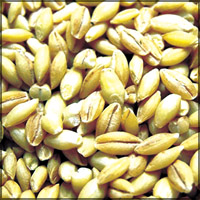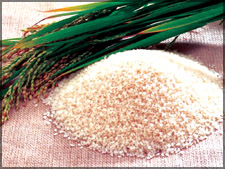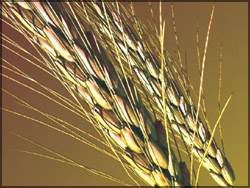Staple food around the world
The staple food is the chief food of the people of a particular
country. Rice is our staple. Some kind of cereal was the staple food of
those people who, many many centuries ago settled down in river valleys
_ the Nile Valley, Tigris-Euphrates Valley, Indus Valley and Hwang Ho
Valley _ and started cultivating the cereals and edible plants that grew
wild in those areas.
Cereals are various types of grass-producing edible (can be eaten)
grains. These cereals became their main food, their staple and they
continued to be cultivated over the centuries right up to modern times.
The cereals which formed the staple of various peoples from ancient
times are rice, maize, wheat, rye, barley and millet.
Maize
Next to rice, this is the most widespread food crop. This cereal is a
native of Central America and the northern part of South America. It was
the staple of the Aztecs of Mexico and the Incas of South America, two
very advanced societies in the American continent before Columbus
discovered this continent. Hordes of Spaniards followed him to what they
called the ‘New World.’
Maize was and still is the staple of the people of Mexico and of some
Indian tribes such as the Hopi of Arizona and the Iroquois who once
occupied what is now New York State and the region to its South.
Iraquois (Iraqwai) were great agriculturists and they had many varieties
of maize. The Hopi, through centuries of selection, have produced a
hardy grain suited to arid harsh conditions.
Aztecs cultivated maize in fields watered by irrigation canals, just
the same way rice was cultivated in the Raja Rata during the days of our
kings, Tortilla is to the people of Mexico what bread is to the
Americans and Europeans. It is a flat cake like our ‘roti’ made with
maize flour.
In most regions of the Inca empire, maize was the staple; in those
regions. Where maize cannot ripen because of the high altitude (height
above sea level) of the Andes mountain, the staple was another cereal
quinoa. Maize is called corn by the Americans. Corn flour sold in
groceries and used in puddings and custards is maize flour. Maize was
introduced to Sri Lanka over 100 years ago and is grown mainly in areas
with not much rain. Maize is ‘Bada iringu’ in Sinhala and ‘Solumn’ in
Tamil.
 Barley Barley
Barley was one of man’s earliest foods. Charred (become black by
burning) barley grains have been found in ancient ruins and tombs. In
some parts of Europe, barley bread was the staple food for many
centuries. Barley bread is a heavy bread. Barley is no longer eaten like
maize or wheat. More than half the crop is used in the form of barley
meal (flour) to feed pigs and cows. Pearl barly - barley ground into
tiny round grains - is used for soups and puddings and for drinking.
Barley water is given to patients.
 Rice Rice
Of all staples, rice was the most cultivated cereal and the one that
was most consumed. Today it is the staple food of about half the
population of the world, and forms the basis of the Asian diet. The main
rice-growing countries are also in Asia; the exception being Brazil.It
is known that China has been growing rice as far back as 3000 BC. When
Alexander conquered Babylon in the Fourth Century BC, he found rice
being cultivated on the banks of the Tigris and Euphrates There are
varieties of rice ranging from the small grains called ‘Samba’ to the
sticky rice, consumed in South East Asia, Japan and China. This variety
of rice is suited to eating with chopsticks. We in South Asia want the
grains of cooked rice to be separate.
 Wheat Wheat
Wheat in the form of bread is now the staple of people in Europe,
America, Canada, Australia, New Zealand and some countries in South
America.
In the earliest days of Babylon and Egypt, wheat was grown. Greece
and Rome followed, making wheat their chief food. Hernan Cortes, the
explorer, took wheat seeds to Mexico early in the 16th Century, and the
English introduced wheat to their colonies in America and the prairies
in Canada and to other countries in the British Empire, and wheat became
the staple in those countries where the climate was suitable for wheat
growing.Wheat is the best cereal for baking bread because it contains
gluten which makes the dough rise and the bread becomes light. Rice has
no gluten.
 Millet Millet
Millet is a grain that has been cultivated from about 4,000 BC. It
was probably first cultivated in Asia or Africa. It is the staple in a
large part of Asia, Russia and Africa. It was the major grain in Europe
in the Middle Ages (395 AD - 13 or 14th Century).There is a large
variety of millet. The variety known as Bajra in India is a popular food
crop in India and Africa.Kurakkan or Kurahan is red millet. It has been
cultivated in our country from ancient times and still is, in the dry
zone. It used to be the staple food of peasants in the dry zone. The
reddish brown shawl that President Mahinda Rajapaksa wears is a symbol
for kurahan, one of the chief food items of the peasants of the
Hambantota district, the President’s home district.It was the
President’s father’s brother D. M. Rajapaksa, the member for Hambantota
in the State Council (1936-1944) who first wore a reddish brown shawl,
the colour of kurahan or kurakkan, the staple of the peasants of the
district he represented.
Rye
This cereal was the staple of the people of the northern countries of
Europe until wheat was introduced. Rye bread was the staple of peasants
and factory workers in many parts of Europe. Rye contains gluten, so rye
bread is light.
Other staples
 What was the staple food of hunters and gatherers and of nomadic
tribes that moves with their animals from place to place, and of those
who lived in small islands where agriculture was not possible? Hunters
and gatherers had no staple as such. They ate whatever yams or tubers or
fruits they collected and the flesh of birds and small animals they
killed. A sort of ‘roti’ made from manioc flour was an important item in
the diet of the Witato, a tribe living in the Amazon jungle.Sweet potato
was the staple of the Maori, the original inhabitants of New Zealand.
Sweet potato taro, a yam like our ‘kiri ala’ and bread fruit are the
main food items of the people of the Pacific Islands like Samoa, Fiji
and Tonga. Milk and the byproducts of milk - whey, cottage cheese and
curd - were staples of pastoral tribes. In winter and when the herds
became very large, the older animals and the unwanted animals were
slaughtered and their flesh eaten. However the Toda, a tribe in South
India never ate the flesh of their buffaloes, the only animals they
reared. The buffalo was a sacred animal. What was the staple food of hunters and gatherers and of nomadic
tribes that moves with their animals from place to place, and of those
who lived in small islands where agriculture was not possible? Hunters
and gatherers had no staple as such. They ate whatever yams or tubers or
fruits they collected and the flesh of birds and small animals they
killed. A sort of ‘roti’ made from manioc flour was an important item in
the diet of the Witato, a tribe living in the Amazon jungle.Sweet potato
was the staple of the Maori, the original inhabitants of New Zealand.
Sweet potato taro, a yam like our ‘kiri ala’ and bread fruit are the
main food items of the people of the Pacific Islands like Samoa, Fiji
and Tonga. Milk and the byproducts of milk - whey, cottage cheese and
curd - were staples of pastoral tribes. In winter and when the herds
became very large, the older animals and the unwanted animals were
slaughtered and their flesh eaten. However the Toda, a tribe in South
India never ate the flesh of their buffaloes, the only animals they
reared. The buffalo was a sacred animal.
- Sumana Saparamadu
|
